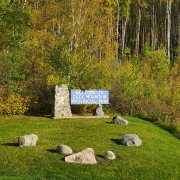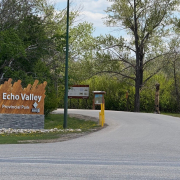Madge Moments: My Trail Start at Duck Mountain
ELLA-VATED TRAILS
Tracing prairie trails through memory, discovery, and home.
By Ella Gidluck, SaskTrails Storyteller
Duck Mountain isn’t new to me.
I’ve spent summers at Madge Lake for as long as I can remember. It’s where my family has a cabin, where we roast marshmallows, take the dogs for long walks, and jump into the lake even when the water feels ridiculously cold. I even worked at Friends of Madge Lake for a summer when I was 16, at the Treats & Treasures store by Ministick Beach. I know this place and its community. It’s part of who I am.
But this summer, I came back with a different purpose, and suddenly, everything looked a little different.
Instead of just visiting, I was here to see. To listen. To learn. I started my trip with a stop at Duck Mountain Lodge: a cozy, red-trimmed building tucked into the trees, with a bright blue sign that makes it impossible to miss. It ended up being one of the best decisions I could have made.
Duck Mountain Lodge, the perfect starting point for my trail storytelling trip.
A Lodge with Heart
The lodge sits right in the woods, tucked away but easy to find if you know where to look. I met April, one of the co-owners, who reopened the space with her partner Jordan in May 2023. From the moment we started talking, I could feel how much she loves this place, not just the lodge, but the park, the trails, and the people who show up year after year.
“Life is so hectic,” she said. “And when you’re out here, it’s just, *she takes a deep breath*… You can breathe.”
I knew exactly what she meant. Just stepping out of the car that morning felt like hitting reset.
April moved from Regina to Kamsack years ago, but Duck Mountain has always been her escape. She talked about frog hunting in creeks as a kid, the kind of childhood joy that sticks with you. Now, she’s building that kind of joy for other people through good food, warm beds, and real conversations.
We chatted in the new café space, where fresh-baked treats sat behind glass and a chalkboard menu hung above the espresso machine. It’s modern and welcoming, with plants tucked between pastries and signs that say things like “Good Vibes Only.” A soft launch now, but it’s clearly becoming something special.
The lodge café serves up smoothies, cinnamon buns, and good vibes.
Most of their visitors are from Manitoba, though more people from Saskatchewan are starting to catch on. She laughed about the number of folks who just stumble across the lodge while walking to the beach. This year feels like their first real summer. People are finally discovering them, and they are ready to welcome them with open arms.
April and I snapped a quick photo in front of the lodge before she darted back to the kitchen. It’s rare to meet someone who’s as passionate about people as she is about good food.
Trail Wisdom
When I asked April about her favourite hikes, she lit up. Her go-to is a loop that starts from the Batka Lake parking lot and winds past Moose Lake, Jackrabbit Shelter, and the ski hill. It’s a solid workout with birdsong for background music and plenty of spots to stop, rest, and breathe.
“It’s like meditation,” she told me. “You just close your eyes and listen.”
That phrase stuck with me. Later in the week, I walked part of that route and thought about what she’d said. The trails I’ve known forever felt unfamiliar in the best way. Like I was being introduced to them for the first time, not by a map, but by someone who truly knows them.
One trail was lined with ferns – waist-high, bright green, and practically glowing in the sun. I’d never noticed them before, not like that. Maybe I just hadn’t slowed down long enough to look.
More Than Just a Meal
Back at the lodge, April’s menu reflects her background as a certified health coach. She does it all: burgers, salads, vegan meals, gluten-free everything, even custom dishes for guests with dietary needs. She’s not just making food. She’s fuelling people, especially those who want to stay active while they’re here.
“I don’t penny-pinch,” she said. “I’m using the real good cheese. It’s not about making money. It’s about people leaving here saying, ‘This is the best plate I ever had.’ That means more to me.”
She also shared her own story of going gluten-free during her training and how it completely changed how she felt, even though she didn’t realize gluten had been affecting her in the first place. That kind of lived experience shows in the way she talks to guests. She’s not just handing out menus. She’s giving people options they didn’t know they needed.
I took my sister, Finlee, to the Lodge for lunch, we ordered pasta… and judging by her double thumbs-up, it was a hit. There’s something lovely about a place that feels this good and feeds you well.
Finlee approved: hearty pasta and happy hikers welcome.
Coming Soon: Coffee and Cinnamon Buns
As if the lodge wasn’t already full of personality, April is now opening a specialty café with homemade donuts, smoothies, cinnamon buns, and milkshakes. I got a sneak peek of the milkshake cookbook. Yes, it includes a Fruity Pebbles one. Yes, I will be back.
She’s easing into it slowly, with more homemade items rolling out as she gains strength and rhythm. Her goal is to offer something good. Not just good enough. Good enough to remember.
Lasting Impressions
Before I left, I asked April how she’d finish this sentence:
“You haven’t truly experienced Duck Mountain until…”
“Until you’ve been here,” she said. “Like really been here. You can’t explain it. You have to feel it.”
I think she’s right.
On one of our last nights, I wandered down to the dock. The clouds were thick, but the sun still found its way through. The lake was still. It felt like the park was quietly saying, “You’re right where you need to be.”
End of day at Madge, where the trails wind down and the reflections start.
This first part of my Madge Lake journey reminded me that familiarity doesn’t mean you’ve seen it all. There’s always another story tucked between the trees, another voice to listen to, another trail waiting to surprise you.
Next up, I take on the Fen Trail, visit Batka Lake Lookout, and learn what happens when you accidentally step off the boardwalk in the name of curiosity. Spoiler: it’s spongy.
This article is part of the SaskTrails Storyteller Series. Thank you to the Saskatchewan Parks and Recreation Association and Trans Canada Trail for supporting this initiative.
Ella Gidluck is the Saskatchewan Trails Association’s 2025 Summer Storyteller. She’s a university student with a love for quiet places, trail snacks, and telling the stories behind the paths we walk.












































